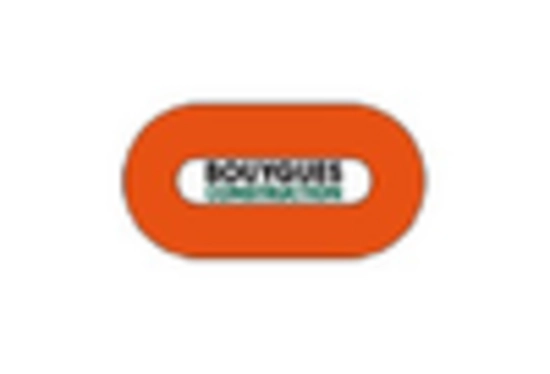Cost Efficiency
The Prefabricated Construction Product Market is increasingly recognized for its potential to reduce construction costs. By utilizing off-site manufacturing techniques, projects can minimize labor expenses and material waste. According to recent data, prefabricated construction can lead to cost savings of up to 20% compared to traditional building methods. This cost efficiency is particularly appealing in a competitive market where budget constraints are prevalent. As construction companies seek to optimize their expenditures, the adoption of prefabricated solutions is likely to rise, thereby driving growth in the Prefabricated Construction Product Market. Furthermore, the ability to complete projects faster due to streamlined processes contributes to overall financial benefits, making prefabrication an attractive option for developers and contractors alike.
Labor Shortages
The Prefabricated Construction Product Market is experiencing a notable impact from ongoing labor shortages in the construction sector. As skilled labor becomes increasingly scarce, companies are turning to prefabricated solutions to mitigate the effects of this challenge. Prefabrication allows for a reduction in on-site labor requirements, as much of the work is completed in a controlled factory environment. This shift not only addresses labor shortages but also enhances productivity and efficiency. Data indicates that the construction industry faces a projected shortfall of millions of workers in the coming years, which could further accelerate the adoption of prefabricated construction methods. Consequently, the Prefabricated Construction Product Market is likely to expand as firms seek innovative ways to overcome workforce limitations.
Regulatory Support
Regulatory support plays a crucial role in shaping the Prefabricated Construction Product Market. Governments are increasingly recognizing the benefits of prefabricated construction, leading to the establishment of favorable policies and incentives. These regulations often aim to streamline the approval processes for prefabricated projects, thereby reducing time and costs associated with traditional construction methods. Recent legislative measures in various regions have been designed to promote the use of prefabricated solutions, particularly in public infrastructure projects. As regulatory frameworks evolve to support innovative construction practices, the Prefabricated Construction Product Market is poised for growth. This supportive environment encourages investment and adoption of prefabricated technologies, ultimately enhancing the industry's overall viability.
Sustainability Initiatives
The growing emphasis on sustainability is a pivotal driver for the Prefabricated Construction Product Market. As environmental concerns gain prominence, construction practices are evolving to prioritize eco-friendly solutions. Prefabricated construction is inherently more sustainable, as it reduces waste and energy consumption during the building process. Recent studies suggest that prefabricated methods can decrease material waste by up to 30%, aligning with global sustainability goals. Additionally, the use of sustainable materials in prefabricated products further enhances their appeal. As governments and organizations implement stricter environmental regulations, the demand for sustainable construction practices is expected to rise, thereby propelling the growth of the Prefabricated Construction Product Market. This trend reflects a broader shift towards responsible construction practices that prioritize environmental stewardship.
Technological Advancements
Technological advancements are significantly influencing the Prefabricated Construction Product Market. Innovations such as Building Information Modeling (BIM) and automation in manufacturing processes are enhancing the efficiency and precision of prefabricated construction. These technologies facilitate better planning, design, and execution, leading to higher quality outcomes. Data indicates that the integration of advanced technologies can reduce construction timelines by up to 50%, making prefabrication an increasingly attractive option for developers. As the construction industry embraces digital transformation, the demand for technologically advanced prefabricated solutions is likely to grow. This trend not only improves project delivery but also positions the Prefabricated Construction Product Market at the forefront of modern construction practices.


















Leave a Comment